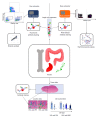Multiparametric analysis of colorectal cancer immune responses
- PMID: 30038466
- PMCID: PMC6054948
- DOI: 10.3748/wjg.v24.i27.2995
Multiparametric analysis of colorectal cancer immune responses
Abstract
Colorectal cancer (CRC) is a heterogeneous disease, with a diverse and plastic immune cell infiltrate. These immune cells play an important role in regulating tumour growth - progression or elimination. Some populations of cells have a strong correlation with disease-free survival, making them useful prognostic markers. In particular, the infiltrate of CD3+ and CD8+ T cells into CRC tumours has been validated worldwide as a valuable indicator of patient prognosis. However, the heterogeneity of the immune response, both between patients with tumours of different molecular subtypes, and within the tumour itself, necessitates the use of multiparametric analysis in the investigation of tumour-specific immune responses. This review will outline the multiparametric analysis techniques that have been developed and applied to studying the role of immune cells in the tumour, with a focus on colorectal cancer. Because much of the data in this disease relates to T cell subsets and heterogeneity, we have used T cell populations as examples throughout. Flow and mass cytometry give a detailed representation of the cells within the tumour in a single-cell suspension on a per-cell basis. Imaging technologies, such as imaging mass cytometry, are used to investigate increasing numbers of markers whilst retaining the spatial and structural information of the tumour section and the infiltrating immune cells. Together, the analyses of multiple immune parameters can provide valuable information to guide clinical decision-making in CRC.
Keywords: Colorectal cancer; Flow cytometry; Immune cells; Immunohistochemistry; Mass cytometry; Microscopy; Multiparametric analysis.
Conflict of interest statement
Conflict-of-interest statement: The authors declare no conflicts of interest.
Figures

References
-
- Stutman O. Tumor development after 3-methylcholanthrene in immunologically deficient athymic-nude mice. Science. 1974;183:534–536. - PubMed
-
- Shankaran V, Ikeda H, Bruce AT, White JM, Swanson PE, Old LJ, Schreiber RD. IFNgamma and lymphocytes prevent primary tumour development and shape tumour immunogenicity. Nature. 2001;410:1107–1111. - PubMed
Publication types
MeSH terms
Substances
LinkOut - more resources
Full Text Sources
Other Literature Sources
Medical
Research Materials

